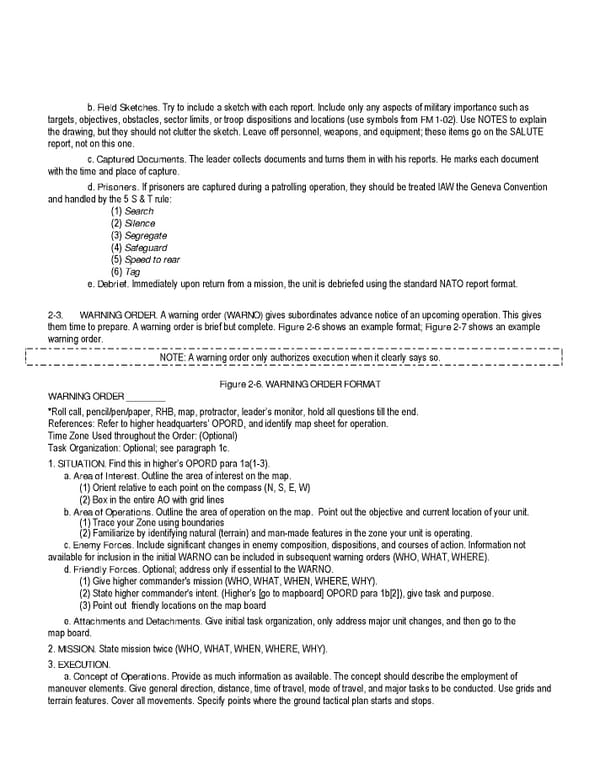b. Field Sketches. Try to include a sketch with each report. Include only any aspects of military importance such as targets, objectives, obstacles, sector limits, or troop dispositions and locations (use symbols from FM 1-02). Use NOTES to explain the drawing, but they should not clutter the sketch. Leave off personnel, weapons, and equipment; these items go on the SALUTE report, not on this one. c. Captured Documents. The leader collects documents and turns them in with his reports. He marks each document with the time and place of capture. d. Prisoners. If prisoners are captured during a patrolling operation, they should be treated IAW the Geneva Convention and handled by the 5 S & T rule: (1) Search (2) Silence (3) Segregate (4) Safeguard (5) Speed to rear (6) Tag e. Debrief. Immediately upon return from a mission, the unit is debriefed using the standard NATO report format. 2-3. WARNING ORDER. A warning order (WARNO) gives subordinates advance notice of an upcoming operation. This gives them time to prepare. A warning order is brief but complete. Figure 2-6 shows an example format; Figure 2-7 shows an example warning order. NOTE: A warning order only authorizes execution when it clearly says so. Figure 2-6. WARNING ORDER FORMAT WARNING ORDER ________ *Roll call, pencil/pen/paper, RHB, map, protractor, leader’s monitor, hold all questions till the end. References: Refer to higher headquarters’ OPORD, and identify map sheet for operation. Time Zone Used throughout the Order: (Optional) Task Organization: Optional; see paragraph 1c. 1. SITUATION. Find this in higher’s OPORD para 1a(1-3). a. Area of Interest. Outline the area of interest on the map. (1) Orient relative to each point on the compass (N, S, E, W) (2) Box in the entire AO with grid lines b. Area of Operations. Outline the area of operation on the map. Point out the objective and current location of your unit. (1) Trace your Zone using boundaries (2) Familiarize by identifying natural (terrain) and man-made features in the zone your unit is operating. c. Enemy Forces. Include significant changes in enemy composition, dispositions, and courses of action. Information not available for inclusion in the initial WARNO can be included in subsequent warning orders (WHO, WHAT, WHERE). d. Friendly Forces. Optional; address only if essential to the WARNO. (1) Give higher commander's mission (WHO, WHAT, WHEN, WHERE, WHY). (2) State higher commander's intent. (Higher’s [go to mapboard] OPORD para 1b[2]), give task and purpose. (3) Point out friendly locations on the map board e. Attachments and Detachments. Give initial task organization, only address major unit changes, and then go to the map board. 2. MISSION. State mission twice (WHO, WHAT, WHEN, WHERE, WHY). 3. EXECUTION. a. Concept of Operations. Provide as much information as available. The concept should describe the employment of maneuver elements. Give general direction, distance, time of travel, mode of travel, and major tasks to be conducted. Use grids and terrain features. Cover all movements. Specify points where the ground tactical plan starts and stops.
 Ranger Handbook Page 27 Page 29
Ranger Handbook Page 27 Page 29